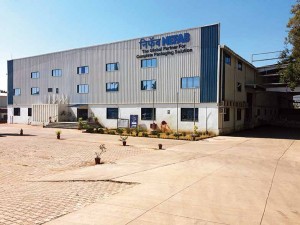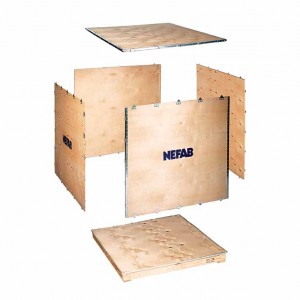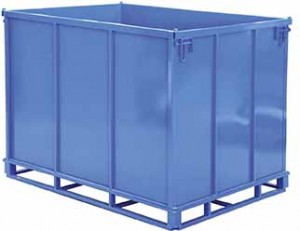NEFAB India wants to be a prominent packaging solutions provider to the auto industry.
Story by: Anusha B
The auto industry is highly price-sensitive, and in need of packaging solutions that are highly cost effective. To cater to these demands of the auto industry, NEFAB India, a wholly-owned subsidiary of NEFAB AB, Sweden, is offering ‘green’ packaging solutions. This, it is confident of, will reduce the environmental impact and packaging material content. Without letting the quality of its products slip, the company is keen to popularise ‘green’ packaging solutions. This is also a part of NEFAB India’s strategy to be the most recognised industrial packaging brand by 2020. For the auto industry, the lucrative part of the ‘green’ packaging solution the company offers, expressed Prasad Mandrolli, Marketing Manager, NEFAB India, is the recycle-ability of materials. “Our business concept is all encompassive. We want to offer complete packaging solutions that reduce total cost, and environmental impact,” mentioned Prasad.
Leveraging experience to address industry needs
An ISO 14001:2004 certified company, Bangalore-based NEFAB India is looking at ‘green’ packaging solutions as a way to carve out a position for itself in a market that is dominated by unorganised players. Prasad is of the opinion, that the packaging sector is dominated by unorganised players that employ corrugated, wooden and steel fabrication materials. Only a few players like Nefab India, claimed Prasad, in the organised sector, use materials that are recyclable. Scant respect for environment, and excessive use of tropical wood, rainforest plywood, etc., is a given according to him. Neither is this sustainable, nor is it good for the environment. It is not in keeping with the strategies that the auto industry is keen to rely on, stated Mandrolli. He opined that there is a need to get the priorities right. There is a need to analyse the impact on the environment of the packaging materilas used. The cost of packaging is offset by reducing the cost of damages.
With manufacturing facilities at Manesar, Pune and Chennai, NEFAB India draws from the experience of its parent in providing packaging solutions to telecom, energy, industry, vehicles, healthcare and aerospace industries. Since 1949, the Swedish company, which clocked a turnover of SEK 3.3 billion in 2016, has grown from a product-oriented company into a market-oriented company. Specialising in complete packaging solutions that reduce their customers’ total costs while minimising environmental impact, the company is keen to create a niche for itself in India. Aware that the packaging industry in India is devoid of major entry barriers and needs low investment, NEFAB India, averred Prasad, has found out that the unorganised players often copy solutions and offer them at a lower price. This is a big challenge, he opined. Confident of carving out a place in the auto industry in India by addressing their exacting needs, NEFAB India, according to Prasad is keen to address the need for standardisation, cost an supply chain requirements. “The automotive industry is highly price-sensitive and the packaging solutions have to be cost effective. Standardisation is a need for this industry,” he explained. Prasad explained that there is a need to offer cost-effective and innovative solutions. He drew attention to services like container loading and lashing that are cost-effective and help to eliminate damages.
Weather challenges
Terming packaging needs of the auto industry as significant, Prasad pointed at factors like weather and impact. “To design a packaging solution, impact and weather change has to be factored in. In sea freight, due to condensation inside a container, a phenomenon called ‘container raining’ takes place,” he added. To absorb moisture, use of container dehumidifying agents like container desiccants are suggested. Desiccants absorb moisture present in the container and prevent ‘container raining’ to affect the packaging as well as the product. Weather challenges also apply to domestic movement. Quite often, ‘close body’ containers as packaging solutions along with container desiccants are advised. Stressing upon the basic function of packaging as a means to assist in product handling, Prasad said, “We design packaging solutions keeping in mind the supply chain and total cost of logistics. This includes multi-material engineering. Typically, the packaging design would vary for fork lift handling, sling, overhead crane and manual handling.”
Entire supply chain has to be considered when a packaging solution is designed. This helps to optimise packaging for various modes of transport, storage and distribution. Packaging is not just a box a designer designs; not for the auto industry for certain. The complex shapes of auto industry products, aggregates, etc., and their nature calls for complex packaging needs. A packaging solution therefore has to be acceptable in a supply chain as well as confirm to the needs of the auto manufacturer. Apart from the modes of transport, storage and distribution details, there is a need to mention the product details and handling precautions.
It is often the case that not one single packaging material a manufacturer suggests to his client. It is material neutral. If there is a need, the manufacturer suggests a hybrid solution. This often comprises of two packaging materials. Typically for an expendable flow, plywood, pinewood, OSB, corrugated boxes, pallets, etc., are suggested. Also suggested is a combination of these packaging materials. For a returnable flow, more sturdy materials like steel, rugged wooden skids, plastic containers, or a combination are used to provide a solution. “All our packaging solutions are RoHS, ISPM 15, FSC and E1 compliant, and suitable for exports to various countries,” expressed Prasad. He said further, “There are several parts that go into the making of a vehicle. It is therefore difficult to have a standard questionnaire for packaging design. When designing expendable packaging solutions for automotive industry, we try to gather information regarding product logistical flows, the supply chain process and storage or shelf details.”
Packaging info
In the case of returnable packaging, the inputs that are needed remain more or less the same as that of an expendable packaging solution. The company however has to also concentrate on gathering information on project life, to and fro flow, and transport costs. Since returnable packaging involves capital investment, it would be useful to know the payback period and the Return on Investment (RoI). Typically, a returnable packaging solution has a certain life period. Returnable flow should be economically viable as there are return freight costs involved. The auto industry accounts for 15 per cent of the company’s turnover according to Prasad. It is steadily growing. “We are not involved in direct exports as of now. A majority of our customers use our packaging solutions to export their products. As of now, a little over 50 per cent of our packaging is used for exports,” Prasad mentioned. It is here that NEFAB India is keen to offer ‘green’ packaging solutions. It is looking at it as a way to understand as well as address the exacting needs of an automotive industry customer. Something, which an organised player can perhaps do better, and attach more value to.
























2 Comments